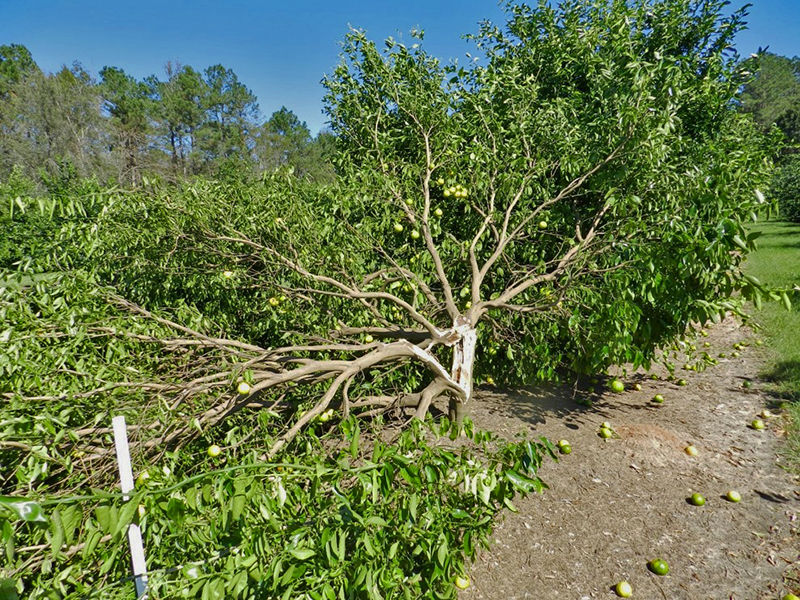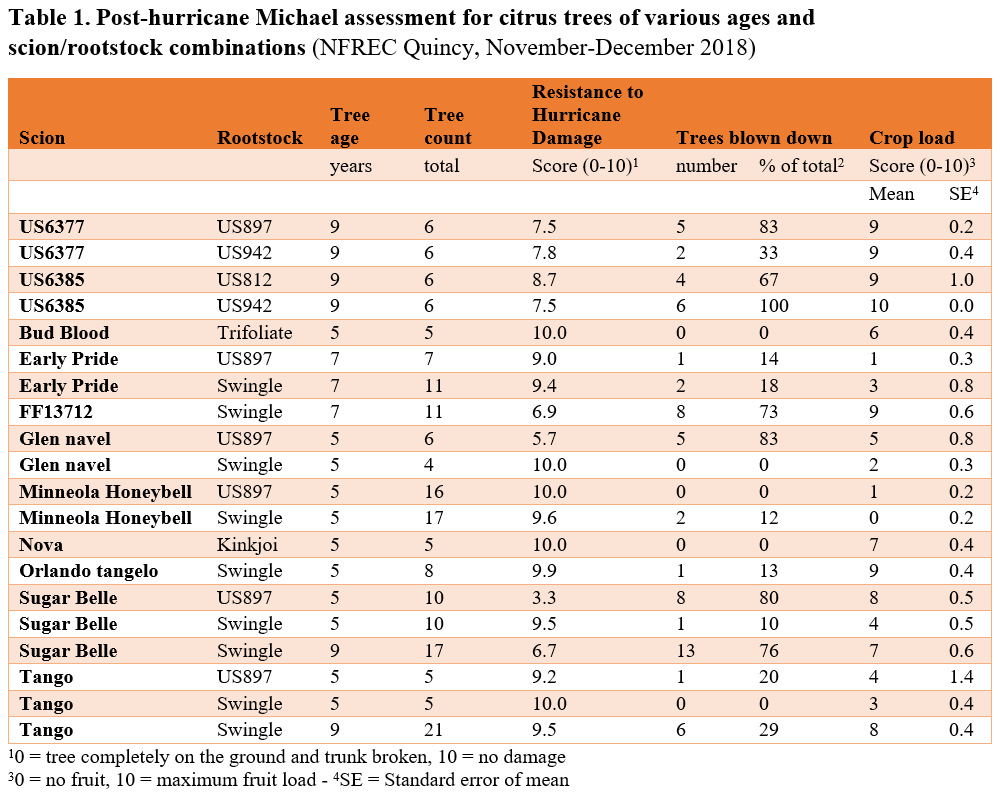On October 10, 2018 Hurricane Michael made landfall at Mexico Beach in the Florida Panhandle as a category 5 storm with 160 mph winds. The eye of this hurricane moved quickly in a northeastward trajectory impacting Marianna, Florida, and points northward. Hurricane Michael retained category 3 status when it crossed the Georgia border and impacted Bainbridge Georgia. It continued its track northward to Albany, Georgia, where it devastated the heart of the Georgia pecan industry. Hurricane Michael produced sustained winds of 55 mph in Gadsden County, as recorded by the Quincy FAWN weather station, although I believe that wind gusts were as high as 70 to 85 mph in the Quincy area. The impact of Hurricane Michael on agriculture was devastating, but the focus of this article is how high winds impacted citrus scions and roostocks under evaluation at the UF/IFAS North Florida Research and Education Center (NFREC) in Quincy, Florida.

Hurricane Michael damaged citrus in Gadsden County, but there were differences based on the varieties and roostock scions being evaluated at the UF/IFAS Research Station near Quincy. Photo credit: P. Anderson, UF/IFAS
At NFREC-Quincy, a citrus evaluation grove was established beginning in 2009 which included the following varieties: US6377, US6385, Bud Blood, Early Pride, FF13712, Glen navel, Minneola Honeybell, Nova, Orlando tangelo, Sugar Belle and Tango. These scions were grown on the following rootstocks: US897, US812, US942, Kinkjoi, Swingle, Trifoliate orange, and US897 (See Table 1 for combinations). Trees were spaced 10 to 12 feet within a row, and 20 feet between rows. Trees were fertilized every 6 weeks from 15 March to 1 August with 10-10-10 (1 to 2 pounds per application depending on tree size).
Some of the citrus trees sustained considerable damage; there were trees with split limbs and trunks and trees that were partially blown over. However, there were no uprooted trees. Some scion-rootstock combinations withstood the hurricane better than others. Crop load was often, but not always, proportional to the resistance to hurricane damage. Other factors that could influence the degree of hurricane injury include the growth habit of the tree, the rootstock, and the inherent strength of the scion wood.
The most serious damage was recorded for Sugar Belle on US897 rootstocks (Table 1), and for US6377 on US897 rootstocks, and for US6385 on US812 and US942 rootstocks. Bud Blood on Trifoliate orange rootstocks, Glen navel on Swingle, Minneola Honeybell on US897, Nova on Kinkjoi and Tango on Swingle all had no discernable hurricane damage (rating of 10). Other combinations, such us Early Pride on US897 and Swingle rootstocks, Minneola Honeybell on Swingle, Orlando on Swingle, Sugar Belle on Swingle and Tango on US897 performed fairly well with a resistance to hurricane damage of 9 or higher. There was a strong rootstock effect on hurricane damage. For example, Sugar Belle on US897 had the most hurricane damage with resistance of 3.3, whereas Sugar Belle on Swingle had a resistance to hurricane damage of 9.5 (5 year old trees) and 6.7 (9 year old trees). In addition, these hurricane prone combinations lost significant amount of fruit to the ground, as compared to combinations that had higher verticality scores.
Although not presented in Table 1, our mature Owari and Brown Select on Trifoliate orange, or Swingle rootstocks sustained no significant storm damage. I attribute this to an umbrella-like canopy of satsumas that easily deflected winds to the sides of the trees. By contrast, Sugar Belle had an upright growth habit and an extremely dense canopy that intercepted a significant amount of wind.
In conclusion, Hurricane Michael was the worst hurricane on record to strike the Florida Panhandle. The economic impact to agriculture in Florida and Georgia was in the billions of dollars. The hurricane caused major damage to trunks and limbs, split some scion-rootstock combinations, while other trees were partially blown over (i.e. Sugar Belle, US6377 and US6385). However, there were some combinations that withstood the hurricane force winds. Owari or Brown Select satsumas on Trifoliate orange or Swingle rootstocks, Bud Blood on Trifoliata rootstocks, Glen navel on Swingle, Minneola Honeybell on Swingle, Nova on Kinkjoi, and Tango on Swingle did not sustain any serious hurricane damage.
- Impact of Hurricane Winds on Citrus Varieties Being Evaluated in Quincy - September 20, 2019
- Quincy Citrus Variety Evaluation Update - March 29, 2019
- Impact of Hurricane Winds on Pecan Varieties - November 2, 2018

